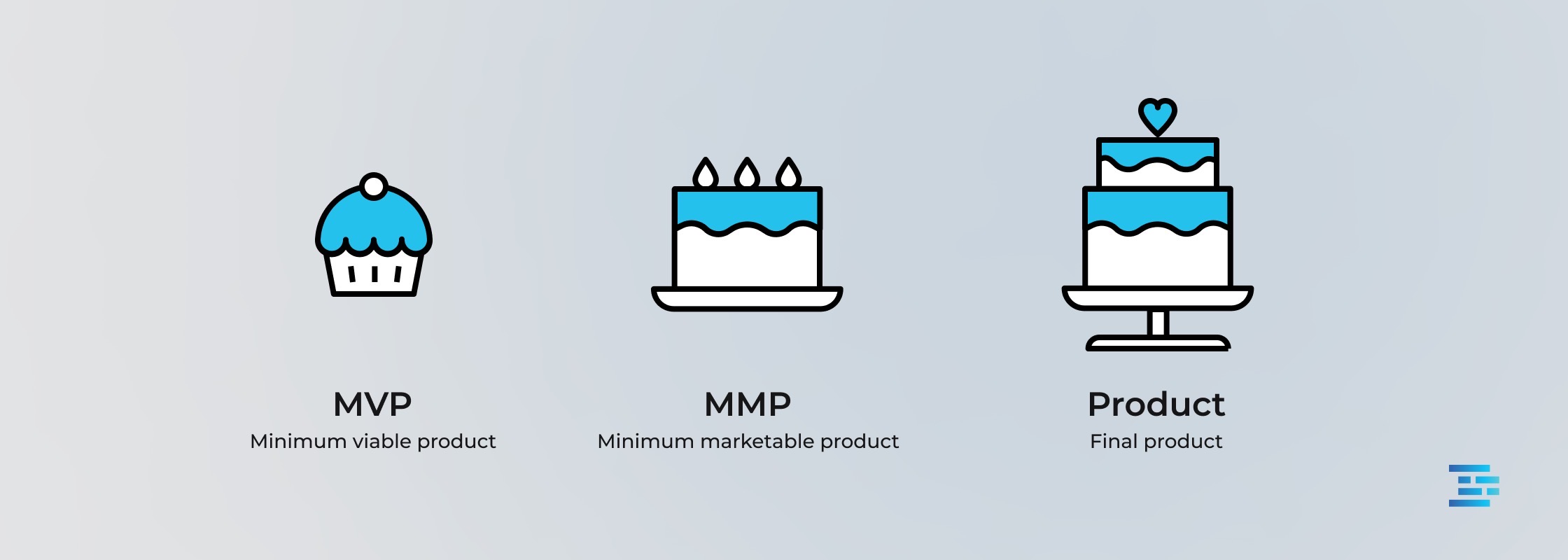The importance of MVPs (Minimum Viable Products) and MMPs (Minimum Marketable Products)
- Summary
- What is an MVP (Minimum Viable Product)?
- What does ‘Minimum Viable’ mean?
- What is an MMP (Minimum Marketable Product)?
- Differences between MVP & MMP
- What are the benefits of an MVP?
- What are the disadvantages of an MVP?
- When should you go for an MVP?
- How does the Minimum Viable Product (MVP) become a Minimum Marketable Product (MMP)?
- What else do you need to convert an MVP into an MMP?
Summary
Importance of MVPs and MMPs
The development of MVPs and MMPs enables companies to test and improve product ideas early before investing significant resources. These models have proven effective in identifying customer needs and successfully bringing products to market.
MVP (Minimum Viable Product)
An MVP checks at an early stage whether a product fulfills users' needs and enables development teams to collect valuable user feedback with minimal effort. Based on this feedback, subsequent improvements can optimize the product idea.
MMP (Minimum Marketable Product)
An MMP is the further development of an MVP that fulfills the minimum requirements for market launch. By involving early adopters, the user experience is improved, and the product is tailored to the target group's needs.
Business benefits for companies
MVPs enable rapid market entry, low-cost testing of business ideas, gathering customer preferences, and early customer base building. The knowledge gained enables companies to avoid undesirable developments and reduce capital losses. They are also attractive to investors.
Are you thinking about a product idea? Or even an idea for an app?
We would rather not discourage you, but hundreds of companies have ideas for the next must-have app.
To ensure the success of your idea, it is crucial to test it as early as possible. After all, who wants to invest vast sums of money in developing a product that doesn't go well with the target group?
Tech companies, in particular, have, for years, relied on the development of so-called MVPs (Minimum Viable Products) and MMPs (Minimum Marketable Products) to test ideas. A prominent example is provided by the founders of Airbnb, who first built a simple website with photos of their flat and thus found their first paying customers.
If you have an idea for a (digital) product, it is worth knowing about the purpose of MVPs and MMPs and their various definitions, Valudio are here to give you the low down.
What is an MVP (Minimum Viable Product)?
A Minimum Viable Product (MVP) is used to test a hypothesis about end-user needs: does the product at hand satisfy user needs – or not?
The MVP validates or falsifies a product idea early in the product development cycle and helps iterate and improve the product idea based on user feedback.
Eric Ries, founder of the Lean Startup Method, defines an MVP as the product version that enables the development team to collect a maximum of validated results with the least effort.
An MVP is a version of a new product which allows a team to collect the maximum amount of validated learning about users, with minimal effort.
Eric Ries
Founder of Lean Startup Method
Thus, MVP is a sub-concept of the Lean Startup method, which Eric Ries described in his 2009 book “Lean Startup”, intended to shorten product development cycles.
The MVP plays a central role in agile software development since agile work is based on validating and iterating products based on user input.
Ultimately, the MVP answers whether end users would buy a product. However, the MVP is never a final product; it only simulates the capabilities of the final product. For example, an MVP can also be a digital product that only pretends to automate a process while manual processes are still being carried out in the background.
What does ‘Minimum Viable’ mean?
A balance between product viability and minimalism characterizes the Minimum Viable Product. It combines both qualities in equal measure.
‘Minimum’
A minimum product fulfills the basic needs of its end users.
‘Viable’
A viable product works for its end users.
A Minimum Viable Product covers the most essential needs of its end-users but nothing beyond that. Therefore, the MVP development process focuses on what a product does rather than how a product does something.
Minimum Viable Products can be anything: a hypothesis of the product idea, a written or visual wireframe, or a simple digital product. The goal of the MVP is solely to allow the first users to test the concept and validate the underlying idea.
What is an MMP (Minimum Marketable Product)?
A Minimum Marketable Product is a product that meets the minimum requirements for market launch. It is the evolution of the MVP and is developed when it is already clear that there is a need. The user experience is further developed with the help of the early adopters of the MVP in the MMP to such an extent that the final target group accepts the product.
Differences between MVP & MMP
| MVP | MMP | |
|---|---|---|
| Dev stage | Start | Pre-launch |
| Focus | Validate an idea | Create added value |
| User | Beta users | End user |
| Goal | Succesful product idea | Successful product launch |
What are the benefits of an MVP?
The business benefits of a Minimum Viable Product are:
- quick time to market (and a possible competitive advantage)
- cost-effective testing of business ideas
- collecting data on target group/customer preferences at an early stage
- early development of a customer base (also called early adopters) and a network who feel involved in product
- development (creating potential brand ambassadors)
- investors are attracted by a functioning MVP and are presented with a tangible value within the MVP
Just as you would calculate the Return on Investment (ROI) of custom software development , with an MVP, insights into the success of a product can be predicted, and potential improvements can be identified even before actual money flows into the production of the final product or a complete product version. The sooner developers find out whether a product will please and benefit end customers, the less effort and costs will have to be spent on a product that fails to succeed.
The MVP allows developers to drastically change or abandon the product based on the feedback gathered. This process is also called ‘validated learning’. Companies can avoid the trap of working on a product that no one ends up using, reduce implementation costs, and avoid capital losses.
What are the disadvantages of an MVP?
Disadvantages often occur when an MVP is misunderstood as a pre-product with the most miniature possible set of functions or half-finished functions. In this form, no meaningful or, in the worst case, only misleading insights can be gained. The MVP is then simply not of high enough quality or, in other words, not viable enough to logically evaluate the end-user experience.
On the other hand, it should also be avoided to develop a fully-fledged end product. Note: a Minimum Viable Product is not a final product.
It is best to create a list of MVP functions and then narrow them to a minimum. Which steps do users have to go through to get added value? Which steps can be dispensed?
Other common obstacles to the development of a successful MVP
Ignorance of market research
Companies frequently need help to abandon their original idea when the insights gained from the MVP testing phase push them to do so. Ignoring market research and survey results and not wanting to deviate from the original idea only promises success in the fewest cases and can quickly become expensive.
Skipping the prototyping phase
Prototyping is an essential step in the development of an MVP. In this phase, the basic structure of the product is defined, and sketches and an interface architecture (for example) are created. Confusion and communication problems can arise in the later development work without doing this preliminary work.
The wrong development team
Companies should look for a development team they trust. An inexperienced team can derail even a unique and viable product idea! The development team should always see itself not only as a technical or executive team but should also be able to communicate with the client at eye level. Most projects fail not because of the technical implementation but because of team communication.
Take a look at the MVP we developed for Lingoda.
When should you go for an MVP?
Mischa Herbrand
CEO, Valudio
You don't necessarily have to build an MVP before you go into the actual product development and build a minimum marketable product. You should always be aware that the main thing here is to recognize your product development phase. If the product is nothing more than an idea so far, it is advisable to validate its assumptions in an MVP phase. You don't necessarily have to develop a product for this. For this phase, you should use as few resources as possible. If you are sure there is a need for the software product, it’s also possible to go straight into product development and create a product roadmap based on which an MMP will be developed. At Valudio, we specialize in just such a scenario.
The development and release of a Minimum Viable Product is worthwhile for companies if:
- A product is to be brought to market as quickly as possible using a concierge approach.
- A product idea is to be tested on real people before a large budget is allocated for the full development of the product, using a Dropbox approach.
- The MVP determines what works and doesn't work with the target audience and ensures that it includes enough features.
Before you start, you should definitely make sure that your MVP aligns with the company's goals. Some concrete questions to consider in advance are:
- Have all the assumptions of my problem to be solved been identified and listed?
- Can I validate my assumptions without developing an MVP?
- Have I talked to all the people involved who might have insights into my problem to solve?
- Does the company have sufficient resources to develop an MVP with enough features?
And the final question should always be: is now the right time to develop an MVP?
Can you answer all the above questions positively, and do you know exactly which issue of the user persona the MVP is supposed to solve? Do you know how your MVP should differ from those of your competitors? Then nothing stops you from developing your Minimum Viable Product, i.e., your product in its beta version.
Do you have a product idea?
We have experience in designing MVPs and MMPs
How does the Minimum Viable Product (MVP) become a Minimum Marketable Product (MMP)?
How much time, work and costs go into the further development of the MVP depends on the stage of development of the MVP:
If a product mockup exists …
… the core offering presented in the mockup must be transformed into an MMP by improving interfaces, incorporating initial user feedback and optimizing the user interface.
If a successful Single Feature MVP exists …
… all that needs to be done is to improve the user experience and focus on customer needs.
If an MLP (Minimum Lovable Product) exists …
… then there already is a product that provides a minimum of functions and usability so that end users can love it. It is, therefore, the antithesis of the Minimum Viable Product (MVP). In most cases, only a few extra refinements or additions are necessary to transform an MLP into an MMP.
If an EVP (Exceptional Viable Product) exists …
… it is an almost finished full version of the MVP that can be brought directly to the market. An EVP, therefore, no longer needs to be converted into an MMP.
MVP and MMP are used more in the field of new product development, where the aim is to sell a product later or to build a new business.
Mischa Herbrand
What else do you need to convert an MVP into an MMP?
First, an MMP should be intuitive to use. To achieve this, companies should rely on experienced UI/UX designers who optimize the frontend (=user interface) of the landing page for use by end customers. Additional features and new features that distract from the product's primary function and the business model should be removed to avoid creating unnecessary confusion among users about the purpose of the product. Implementing the feedback collected on the MVP in the MMP is equally essential.
In the case of applications that are developed to digitalize internal company processes or to improve the customer experience of an already existing product, the development of the final product can be started immediately. However, the applications must still be tested on all future user groups and discussed with them to design the best possible solution.




